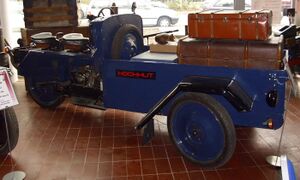Engineering:Goliath Rapid
| Goliath Rapid / Goliath Standard | |
|---|---|
 | |
| Overview | |
| Manufacturer | Bremer Kühlerfabrik Borgward & Co. GmbH, Bremen, Germany |
| Production | Goliath Company, Bremen, Germany |
| Model years | 1925 or 1926-1933 |
| Designer | Carl F. W. Borgward |
| Body and chassis | |
| Body style | open three-wheel cart |
| Layout | Kardan MR layout |
| Powertrain | |
| Engine | two-stroke engine (4–9 PS) |
| Transmission | 3 speed |
| Dimensions | |
| Wheelbase | ~ 79 in (2,000 mm)[1] |
| Chronology | |
| Predecessor | Goliath Blitzkarren |
| Successor | Goliath F400 and F200 |
The Goliath Rapid is a lorry made by Bremer Kühlerfabrik Borgward & Co. GmbH in Sebaldsbrück (a neighborhood in Hemelingen, a suburb of Bremen, Germany). The Rapid, which technically was an improved version of the Goliath Blitzkarren, was sold under the Goliath brand name. Bordward's radiator-producing company was later renamed to Goliath-Werke Borgward & Co. GmbH.
The Rapid consists of two parts: A "cart"-like front with two steerable wheels, and a "motorcycle" rear part with a single wheel. Between cart a motorcycle, it has an orthogonal wall and a steering wheel, to control the front wheels. A windshield was offered as a factory option. The Rapid has an electric starter, a clutch, and a 3-speed gearbox with a single reverse gear. Electric lamps including a stoplight were offered as a factory option that cost RM 170; an electric horn was offered for RM 30. The maximum permissible payload is 250 kg. The Rapid is powered by an ILO-Motorenwerke-made 198 cc, single cylinder, two-stroke-engine that produces 4 PS. In 1928, a new model with an increased payload of up to 300 kg and a 250 cc, 5.5 PS engine was put into production. In 1931, the payload was increased to 500 kg. A version with a framed flatbed was offered for RM 1100; a closed freight box version was available as well, for RM 1200. Odometer or a passenger seat also offered from the factory. Carl Borgward had filed a patent on "single rear wheel drive technology". The patent was granted on 8 August 1928.[2]
Goliath Standard
In addition to the Rapid, a 500 kg freight version called Goliath Standard was put into production. It has a 350 cc single cylinder, two-stroke gasoline engine made by ILO-Motorenwerke with a rated power of 7.5 PS. Its flatbed version cost RM 1295, the "closed freight-box" version was offered for RM 1440. The Standard's top speed is 40 km/h (25 mph).[3]
In 1931, a 750 kg freight version with a 400 cc two cylinder engine rated 9 PS cc was introduced. In 1931, prices rose to RM 1600 resp. RM 1750.
In 1933, the Standard production was ceased – the successors Goliath F200 and F400 were put into production in autumn of 1933.[4][5][6]
Competitors
- Oscar Vidal & Sohn Tempo Pony, T1 and T2, built from 1928 to 1930, a very similar vehicle
- D-Lieferwagen L-7, 1927–1930
- Later in 1932–1934, BMW produced a similar freight cart and sold it as BMW F 76 and F 79 with bigger engine. It included a passenger seat.
- Rollfix record, also late for the market
- In late 1940s til 1952 Innocenti produced the Lambretta models FA, FB and FC
- Tatra 49, 1929–1930
References
- ↑ "Archived copy". https://www.automobilia-ladenburg.de/image/pool/2/mx/913.jpg.
- ↑ https://patents.google.com/patent/DE496683C/en Patent DE496683C: „Drive device for the rear drive wheel of a three-wheeled motor vehicle“, Google Patents
- ↑ "Typ". http://www.borgward.org/Goliath/GStandard.htm.
- ↑ "Typenblatt-Rapid-Standard". http://www.goliath-veteranen-club.de/Typologie/Typenblatt-1926-Rapid-Standard.htm.
- ↑ "Das Ende des Bremer Wirtschaftswunders" (in de). Syke. 2013-07-27. https://www.kreiszeitung.de/lokales/bremen/ende-bremer-wirtschaftswunders-3027345.html.
- ↑ Flieger, Heinz (1959) (in de). Der Weg zur Isabella: eine Geschichte der Borgward-Gruppe. Verlag für Deutsche Wirtschaftsbiographien. pp. 58. https://books.google.com/books?id=47sdAQAAMAAJ.
External links
- Volker Schacht: A Goliath Rapid/Standard at the 27th International Threecycle Meeting 2015, YouTube, 24 June 2015
- List of remaining Goliath vehicles , retrieved February 2019
- Sales brochure of the Goliath Rapid/Standard
 |


